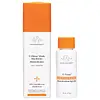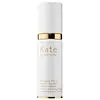What's inside
What's inside
 Key Ingredients
Key Ingredients

 Benefits
Benefits

 Concerns
Concerns

No concerns
 Ingredients Side-by-side
Ingredients Side-by-side

Water
Skin ConditioningDimethyl Isosorbide
SolventAscorbic Acid
AntioxidantLaureth-23
CleansingGlycerin
HumectantTocopherol
AntioxidantLactobacillus/Pumpkin Ferment Extract
Skin ConditioningSclerocarya Birrea Seed Oil
HumectantDipotassium Glycyrrhizate
HumectantGlycyrrhiza Glabra Root Extract
BleachingVitis Vinifera Juice Extract
AntioxidantFerulic Acid
AntimicrobialPhyllanthus Emblica Fruit Extract
HumectantCamellia Sinensis Leaf Extract
AntimicrobialLactobacillus/Punica Granatum Fruit Ferment Extract
Skin ConditioningPropanediol
SolventGluconolactone
Skin ConditioningSodium Hyaluronate Crosspolymer
HumectantSodium Hyaluronate
HumectantOryza Sativa Bran Extract
Skin ConditioningGlutamylamidoethyl Imidazole
Tetrahydrobisdemethoxydiferuloylmethane
AntioxidantTetrahydrodemethoxydiferuloylmethane
AntioxidantTetrahydrodiferuloylmethane
AntioxidantPentylene Glycol
Skin ConditioningCaprylhydroxamic Acid
Leuconostoc/Radish Root Ferment Filtrate
AntimicrobialSorbic Acid
PreservativePhenoxyethanol
PreservativeSodium Benzoate
MaskingCaprylyl Glycol
EmollientChondrus Crispus Extract
Skin ConditioningEthylhexylglycerin
Skin ConditioningWater, Dimethyl Isosorbide, Ascorbic Acid, Laureth-23, Glycerin, Tocopherol, Lactobacillus/Pumpkin Ferment Extract, Sclerocarya Birrea Seed Oil, Dipotassium Glycyrrhizate, Glycyrrhiza Glabra Root Extract, Vitis Vinifera Juice Extract, Ferulic Acid, Phyllanthus Emblica Fruit Extract, Camellia Sinensis Leaf Extract, Lactobacillus/Punica Granatum Fruit Ferment Extract, Propanediol, Gluconolactone, Sodium Hyaluronate Crosspolymer, Sodium Hyaluronate, Oryza Sativa Bran Extract, Glutamylamidoethyl Imidazole, Tetrahydrobisdemethoxydiferuloylmethane, Tetrahydrodemethoxydiferuloylmethane, Tetrahydrodiferuloylmethane, Pentylene Glycol, Caprylhydroxamic Acid, Leuconostoc/Radish Root Ferment Filtrate, Sorbic Acid, Phenoxyethanol, Sodium Benzoate, Caprylyl Glycol, Chondrus Crispus Extract, Ethylhexylglycerin
Water
Skin ConditioningDimethicone
EmollientPropanediol
SolventPolysilicone-11
Polysorbate 20
EmulsifyingIsocetyl Stearate
EmollientVolcanic Soil
Skin ConditioningGlyceryl Stearate
EmollientIsohexadecane
EmollientPEG-100 Stearate
Parfum
MaskingRetinol
Skin ConditioningAscorbic Acid
AntioxidantTocopheryl Acetate
AntioxidantHyaluronic Acid
HumectantPhysalis Angulata Extract
Skin ProtectingSodium Hyaluronate
HumectantTocopherol
AntioxidantHexapeptide-2
BleachingEthylhexylglycerin
Skin ConditioningAmylopectin
PEG-7 Trimethylolpropane Coconut Ether
EmulsifyingAdenosine
Skin ConditioningHydroxyethyl Acrylate/Sodium Acryloyldimethyl Taurate Copolymer
Emulsion Stabilising1,2-Hexanediol
Skin ConditioningButylene Glycol
HumectantAmmonium Polyacryloyldimethyl Taurate
Emulsion StabilisingCaprylic/Capric Triglyceride
MaskingPolyisobutene
Sorbitan Isostearate
EmulsifyingStearic Acid
CleansingPolysorbate 80
EmulsifyingDimethiconol
EmollientCaprylhydroxamic Acid
BHA
AntioxidantBHT
AntioxidantDisodium EDTA
Water, Dimethicone, Propanediol, Polysilicone-11, Polysorbate 20, Isocetyl Stearate, Volcanic Soil, Glyceryl Stearate, Isohexadecane, PEG-100 Stearate, Parfum, Retinol, Ascorbic Acid, Tocopheryl Acetate, Hyaluronic Acid, Physalis Angulata Extract, Sodium Hyaluronate, Tocopherol, Hexapeptide-2, Ethylhexylglycerin, Amylopectin, PEG-7 Trimethylolpropane Coconut Ether, Adenosine, Hydroxyethyl Acrylate/Sodium Acryloyldimethyl Taurate Copolymer, 1,2-Hexanediol, Butylene Glycol, Ammonium Polyacryloyldimethyl Taurate, Caprylic/Capric Triglyceride, Polyisobutene, Sorbitan Isostearate, Stearic Acid, Polysorbate 80, Dimethiconol, Caprylhydroxamic Acid, BHA, BHT, Disodium EDTA
 Reviews
Reviews

Ingredients Explained
These ingredients are found in both products.
Ingredients higher up in an ingredient list are typically present in a larger amount.
Ascorbic Acid is is pure Vitamin C. This form makes up the largest amount of vitamin C found naturally in our skin.
Not only is vitamin C great for your overall health and immune system, it also has plenty of benefits on your skin.
Vitamin C is best used for brightening skin. It improves dark spots, acne scars, and hyperpigmentation. This is because it blocks the process of skin darkening when exposed to UV.
Remember: Vitamin C should not replace sunscreen!
Your skin uses vitamin C to build collagen. Collagen is one key component in having a strong skin barrier and plump skin. Vitamin C also plays a role in regulating collagen, thus making it effective in improving wrinkles and fine lines.
Ascorbic acid shows potent antioxidant activity. As an antioxidant, it helps fight free-radicals. Free-radicals are molecules that may damage your skin cells. These antioxidants also protect skin against UV damage.
The best formulations include Vitamin E and/or ferulic acid. These two ingredients help stabilize and provide a boost in the benefits of ascorbic acid. This is because ascorbic acid becomes unstable when exposed to UV and air. In fact, you can tell your ascorbic acid has oxidized when it turns an orange-yellow color.
Ascorbic acid is generally compatible with other ingredients. However, using ascorbic acid with other active ingredients might cause irritation. Two ingredients: copper ions and benzoyl peroxide, will inactivate ascorbic acid completely.
Read more about other types of Vitamin C:
Foods rich with vitamin C include oranges, strawberries, broccoli, bell peppers, and more. When consuming Vitamin C, your skin receives a portion of the nutrients.
Learn more about Ascorbic AcidCaprylhydroxamic Acid is a chelating agent.
Chelating agents help prevent metal ions from binding to other ingredients. This helps prevent unwanted reactions and effects from using the product.
Caprylhydroxamic Acid is often used with natural antimicrobial products as an alternative to preservatives.
Learn more about Caprylhydroxamic AcidEthylhexylglycerin (we can't pronounce this either) is commonly used as a preservative and skin softener. It is derived from glyceryl.
You might see Ethylhexylglycerin often paired with other preservatives such as phenoxyethanol. Ethylhexylglycerin has been found to increase the effectiveness of these other preservatives.
Propanediol is an all-star ingredient. It softens, hydrates, and smooths the skin.
It’s often used to:
Propanediol is not likely to cause sensitivity and considered safe to use. It is derived from corn or petroleum with a clear color and no scent.
Learn more about PropanediolSodium Hyaluronate is hyaluronic acid's salt form. It is commonly derived from the sodium salt of hyaluronic acid.
Like hyaluronic acid, it is great at holding water and acts as a humectant. This makes it a great skin hydrating ingredient.
Sodium Hyaluronate is naturally occurring in our bodies and is mostly found in eye fluid and joints.
These are some other common types of Hyaluronic Acid:
Learn more about Sodium HyaluronateTocopherol (also known as Vitamin E) is a common antioxidant used to help protect the skin from free-radicals and strengthen the skin barrier. It's also fat soluble - this means our skin is great at absorbing it.
Vitamin E also helps keep your natural skin lipids healthy. Your lipid skin barrier naturally consists of lipids, ceramides, and fatty acids. Vitamin E offers extra protection for your skin’s lipid barrier, keeping your skin healthy and nourished.
Another benefit is a bit of UV protection. Vitamin E helps reduce the damage caused by UVB rays. (It should not replace your sunscreen). Combining it with Vitamin C can decrease sunburned cells and hyperpigmentation after UV exposure.
You might have noticed Vitamin E + C often paired together. This is because it is great at stabilizing Vitamin C. Using the two together helps increase the effectiveness of both ingredients.
There are often claims that Vitamin E can reduce/prevent scarring, but these claims haven't been confirmed by scientific research.
Learn more about TocopherolWater. It's the most common cosmetic ingredient of all. You'll usually see it at the top of ingredient lists, meaning that it makes up the largest part of the product.
So why is it so popular? Water most often acts as a solvent - this means that it helps dissolve other ingredients into the formulation.
You'll also recognize water as that liquid we all need to stay alive. If you see this, drink a glass of water. Stay hydrated!
Learn more about Water